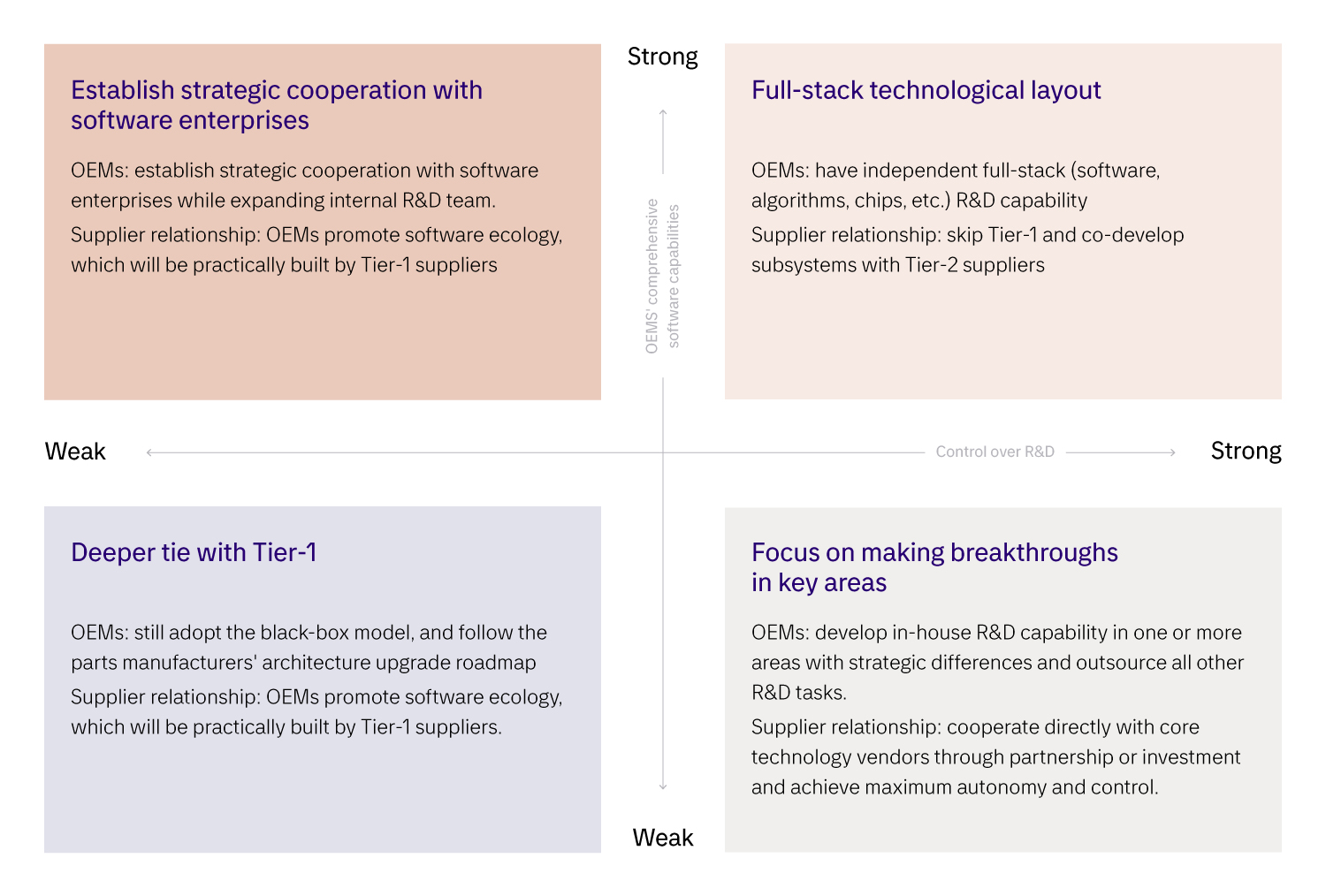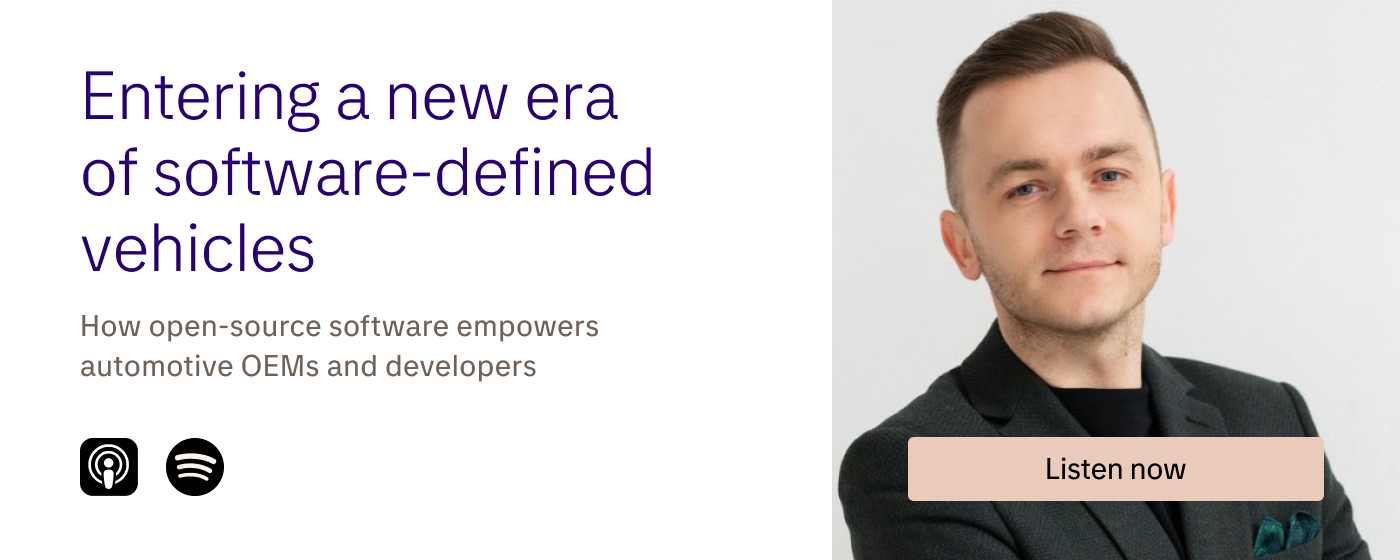
Top Software-Defined Vehicle Trends for 2025
Explore the latest industry and tech trends that are paving the way to the cutting-edge SDV vehicles of tomorrow.
The world is now moving to software-defined vehicles (SDV), which enable intelligent, safe, and personalized driving experiences with digital solutions. Despite hitting a speed bump, SDV will remain a core concept that shapes the future of the automotive industry. Let’s explore the key SDV trends for 2025 and beyond that bring us closer to the new age of mobility.
Just like the internal combustion engine revolutionized transportation in the 19th century, advanced software has now become a focal point that defines the evolution of vehicles and mobility landscape. The automotive industry is now entering a new stage where OEMs - Original Equipment Manufacturers are transforming into Original Experience Manufacturers. Cutting-edge software drives this groundbreaking shift, redefining conventions and revolutionizing the entire driving experience.
After a decade of ongoing advancements, the promise of SDV has recently faced a reality check. All players across the automotive value chain have come to realize that the next-gen SDV capabilities appear to be further away than expected. This happened due to OEMs’ legacy ways of working that led to the lack of agility and the inability to adapt fast to ongoing industry changes and innovations. Additionally, the growing complexity of automotive platforms brings further challenges that can be addressed by incorporation of modern software development practices (including CI/CD and CT pipelines).
While past discussions around SDV pivoted mostly around promised endless opportunities enabled by software, now we observe more mature conversations depicting challenges that need to be overcome to realize a software-defined future. We could observe this during the recent Car IT Symposium - SDV is not only about putting more software in a car but rather answering the question “Why do we want to do it?”. The seems to be quite simple, yet challenging in implementation—ultimately, it’s about reducing costs and time to market.
Nevertheless, software-defined vehicles remain the cornerstone that steers the automotive industry forward. 43% of automotive executives think that SDV will face widespread adoption within the next 5 years, while 47% believe that it will require from 5 to 10 years, as per Deloitte.
Ultimately, the global SDV market value has the potential to grow up to USD 449.5 billion by 2034, driven by the growing demand for advanced in-car experiences, autonomous driving, and smart mobility, along with the rapid development of ADAS (with clear focus on L2+ and L3 levels of autonomy), over-the-air (OTA) updates, as well as the expansion of advanced connectivity (5G/6G/NTN), cloud, and AI.
To navigate the existing challenges, respond to the new market demands, and capture the SDV opportunity, OEMs are now undergoing a significant organizational shift, which brings us to the first SDV trend.
Software-Driven Transformation of OEMs
The way OEMs design and produce vehicles is now largely dependent on software. This comes with a certain price, according to PwC consulting research over 34% of vehicle launches in North America in 2023 faced delays – given the growing complexity of automotive platforms, it shouldn’t be a surprise that software remains one of the main delay culprits. Despite the major challenges related to software, OEMs are moving away from traditional hardware-centric operations, and initiating a software-driven organizational change remains inevitable.
A growing number of OEMs are now centering their strategy on a software-focused vision, extending their in-house software engineering capabilities, and forming dedicated R&D centers to develop proprietary automotive software. The R&D approaches may vary – some OEMs choose to focus on specific business-critical use cases, or build robust and independent R&D capabilities, while others cooperate with software engineering companies to fill in the needed expertise gaps.
Software-driven transformation is also reshaping OEMs position strategies – by stepping outside traditional role of assembling car parts and integrating hardware/software black boxes. RIVIAN - a greenfield OEM - emphasizes its identity as a "technological company" rather than solely a car manufacturer, a sentiment that strongly resonates within the industry. Similarly, Volvo's CTO has articulated that the company now identifies itself not only as an automotive producer but also as a software company, highlighting the evolving landscape of the sector.
Key R&D Strategies for Automotive OEMs

However, what we already observed is also that building a software-first-mindset division within a wide, legacy organization is not an effortless task after all for OEMs. That’s why car manufacturers recognized that they cannot truly cope with the complexities of automotive software engineering by themselves, which leads us to the next two major SDV trends.
Strategic partnerships
The need to establish strong partnerships between OEMs, semiconductors and technology companies to facilitate SDV development has been discussed already for some time. The conclusion from numerous automotive conferences was straightforward – SDV remains a complex challenge, and it cannot be solved in isolation by any company. By fostering synergies within the industry, we need to find common solutions for common challenges and stop reinventing the wheel all over again – at least for non-differentiating components. By forging such partnerships, OEMs can access specialized technical expertise, reduce costs, mitigate risks, and significantly accelerate the time-to-market of advanced SDV features.
As we mentioned earlier, to own a significant stake of the value creation that would give OEMs more control over the process, they need to build a strong software-oriented organization. However, achieving it in isolation remains extremely hard if not unattainable after all. That makes partnership topic more important than ever. What we’re witnessing today is a shift from a traditional supply chain to a partnership-driven relationship built on co-creation and joint innovation activities.
We cannot forget about long-established, and well recognized automotive alliances, including AUTOSAR – a global partnership of OEMs and tech companies founded to standardize the software framework and E/E architecture for smart mobility, COVESA – an alliance that focuses on addressing industry common challenges (like vehicle data fragmentation), and Eclipse SDV that aims to accelerate innovation of automotive software stacks through a vibrant open source community.
The Utilization of Open-Source Software
Another important trend that reinforces industry-wide collaboration and brings us closer to SDV is the utilization of open-source software (OSS). It serves as the foundation for creating non-differentiating, seamlessly interoperable software modules, which can be used to develop common architectures and standardized digital solutions. OSS empowers both OEMs and developers with a full range of benefits:
- Significantly reduced costs
- Access to a transparent codebase
- Flexibility that allows tailoring the software to the unique needs of OEMs
- Continuous collaboration and knowledge sharing that promotes innovation
The importance of OSS can be illustrated in the case of Mercedes-Benz and its brand-new MB.OS – a system that standardizes the hardware and software across the infotainment, autonomous driving, comfort, and driving/charging domains. Mercedez-Benz utilized software components from the Free & Open-Source Software (FOSS) community to rapidly produce high-quality code for the system, which was essential for the success of MB.OS.
Furthermore, the overall amount of OSS components in the Mercedes vehicles has significantly increased – from 794 components in the 2018 A-class model up to 3166 FOSS components in the 2023 Mercedes-Benz E-class.
However, the utilization of OSS also presents a range of challenges for OEMs, such as vehicle safety-related issues, and selecting the right approach for software maintenance (either in-house or community-based).
If you’d like to learn more about the ins and outs of OSS in the automotive industry, check out our Data Insiders podcast episode with Moritz Neukirchner, Senior Director of SDV Product Management at Elektrobit.
Platform Consolidation & Automotive OS
The development of automotive software is still mostly fragmented and isolated. An OEM’s in-house engineers can develop specific software modules, while others are purchased from third parties, and then merged in a proprietary hardware platform. This approach results in integration complexities and excessive costs, as an SDV vehicle with ADAS, OTA updates, and other advanced features requires hundreds of software modules. In a famous episode of Fully Charged Podcast Jim Farley, CEO of Ford has stated:
It’s so difficult for car companies to get software right. We have about 150 modules across the car, developed by 150 different companies, written in >100 different languages, that don’t talk to one another.
Such fragmentation is addressed by centralized and zonal architectures strengthened by platform consolidation – a trend that is now rapidly gaining momentum.
With platform consolidation, OEMs can enable end-to-end integration and seamless interoperability of discrete software modules across SDV architecture. The use of platforms that are built on a unified codebase can help automotive players optimize development costs, resolve software performance bottlenecks, and streamline the rollout of new SDV features, while also enhancing vehicle security. Additionally, the growing power of vehicle HPCs (high-performance computing platforms) creates the possibility to host multiple software domains, including mixed criticality, thereby reducing the number of ECUs, wiring, and weight. One great example is the Volvo Superset Tech Stack (based on NVIDIA and Qualcomm high-super computers), unified hardware and software modules powering current and future vehicles. As Tietoevry Create we’re excited to participate in the development of the stack - see our success story to learn how Tietoevry Create helped HaleyTek, a renowned automotive software company, develop an AAOS-powered software platform for smooth in-car audio experiences.
Platform consolidation needs to be strengthened by the Automotive OS, often referred to as Car.OS. Traditional vehicles can have up to hundreds of diverse ECUs. Even with progressing platform consolidation and reducing the numbers of vehicle computers, there’s still a need to address software integration, updates, and maintenance complexities.

There are different definitions of Automotive OS. We might consider it as a software platform that abstracts the entire cluster of vehicle ECUs as a “single device”, which is managed and updated in a holistic manner. As a result, OEMs can benefit from a perfectly balanced SDV architecture, frictionless integrations, and optimized development costs. However, as we can see in the above schema from Dirk Linzmeier from TTTech Auto, Automotive OS or Car.OS could be considered in a bit wider, ecosystem-based perspective.
Virtualization & The Shift-Left Approach
One of the goals of SDV is to shorten the time-to-market, enabling OEMs to provide customer value through software, continuously throughout the vehicle lifetime. By embracing cloud-native development practices, OEMs can maximize flexibility and scalability. With cloud-native technologies, such as CI/CD/CT, containerization, and APIs, automotive players can accelerate software deployments, efficiently manage in-vehicle systems, and seamlessly integrate them with third-party applications and services.
This can be further strengthened by virtualization. In essence, it allows creating a “Digital Twin” (or vECU) of the vehicle’s ECUs in a simulated cloud-based environment before the physical, target hardware is available. By applying virtualization, OEMs can rapidly develop, test, and validate software for multiple vehicle components while significantly reducing hardware costs and shortening time-to-market.
Utilization of cloud technologies with virtualization is the key essence of the “shift-left” and “software-first” approach. We can begin the development and testing process quicker by taking advantage of the environmental parity between virtualized ECUs and embedded target platforms without having to wait for the target hardware. Not only does the shift-left approach improve test coverage and enhance software quality and thus reliability, but also tremendously streamlines the whole software development process. One of the prominent examples comes from Tietoevry Create’s customer – Panasonic Automotive – with vSkipGen platform that enables software teams to develop target code without relying on target hardware, streamlining the product development process and enhancing product quality. This virtual replica of advanced cockpit domain controller (CDC) facilitates parallel and iterative development processes, breaking away from the traditional sequential approach where software development usually trails behind early hardware development stages.
AI-Driven Engineering & Enhanced In-Vehicle Experiences
Finally, one of the core tech trends that is instrumental for the advancement of SDV vehicles is artificial intelligence. There are a few areas where AI can become a game-changer for automakers – software development, enhancement of in-vehicle experiences and data-driven insight.
OEMs can use AI-based solutions to rapidly design, engineer, test, fine-tune, and deploy software for SDV vehicles, thus accelerating the entire SDLC. In addition, AI can be applied to facilitate requirements engineering, including elicitation, analysis, specification, and other related processes. Overall, AI can serve as a valuable tool to boost the productivity of OEM’s in-house IT teams and R&D centers, while also improving software quality and reducing costs.
Soon we will observe proliferation of so-called vertical AI agents that have been built for specific industry. We can already witness it with GenAI-powered voice assistants that are gaining momentum among OEMs. Such digital assistants can respond to drivers and passengers in an intuitive, conversational manner and provide them with the requested information, tailored recommendations, etc. For example, the previously mentioned new Mercedes-Benz CLA model utilizes ChatGPT and Google Gemini to enable a more natural way of interacting with the vehicle system. The vehicle's assistant, depicted by a Mercedes-Benz star avatar, can respond to your open-ended questions in real time and can also gauge your emotions through the tone of your voice.
However, it’s worth noticing that potential of AI-based solutions for the industry goes far beyond vehicle software – from predictive maintenance on production line, through supply chain optimization (among different use cases).
Conclusion
Despite hitting a temporary speed bump, SDV vehicles have the potential to get back to the fast lane of innovation and forever change the traditional hardware-based automotive conventions. However, the dynamic proliferation of software in vehicles presents numerous challenges, with cybersecurity concerns being one of the most crucial to address. That’s why cybersecurity shouldn’t be considered a trend - it’s rather a core priority for OEMs and service providers.
Nonetheless, rapid advancements in connectivity, cloud, and AI, along with the collaborative and software-focused modus operandi of OEMs drive us onward into a new future, where vehicles are an integral component of our digital lifestyle that offers ultimately smart, safe, and convenient driving experience for everyone.
It’s worth noting that SDV is not only about the vehicle. It’s a multidomain challenge that integrated complex ecosystem that enables OEMs to provide customer value through software.
With 20+ years of industry experience, Tietoevry Create offers the most holistic suite of automotive software services, ranging from expert consulting and embedded engineering to connectivity and cybersecurity to help you create next-gen SDV solutions.
Contact us and let’s reinvent the future of mobility together!

Piotr aims to bridge people and businesses to make great projects happen. He is a massive enthusiast of software-defined vehicles and Android Automotive OS platforms. He supports various automotive industry alliances to help accelerate the potential of connected cars.
Read the latest blog posts
-
 Digitalization / Stefan Novoszel / 2.10.2025
Digitalization / Stefan Novoszel / 2.10.2025Business servitization: set yourself up for success
Discover the benefits of expanding your traditional product offerings towards a service-centric business model
-
 Digitalization / Piotr Krawczyk / 19.9.2025
Digitalization / Piotr Krawczyk / 19.9.2025Technical Challenges of Software-Defined Vehicles
Discover how to address SDV development roadblocks with virtualization, service-oriented architecture, and standardized data models.
-
 Digitalization / Piotr Romanowski / 13.6.2025
Digitalization / Piotr Romanowski / 13.6.2025Lessons from EuCNC & 6G Summit
Tietoevry Create’s Automotive & Manufacturing Principal Piotr Romanowski explores the lessons the connectivity industry can learn from the research-oriented event.

